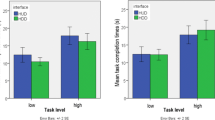Abstract
Distraction effects of three alternative touch screen scrolling methods for searching music tracks on a mobile device were studied in a driving simulation experiment with 24 participants. Page-by-page scrolling methods with Buttons or Swipe that better facilitate resumption of visual search following interruptions were expected to lead to more consistent in-vehicle glance durations and thus on less severe distraction effects than Kinetic scrolling. As predicted, Kinetic scrolling induced decreased visual sampling efficiency and increased visual load compared with Swipe, increased experienced workload compared with both Buttons and Swipe, as well as decreased lane-keeping accuracy compared with baseline. However, Buttons did not significantly excel Kinetic with any metric but on subjective ratings. Based on the results, we do not recommend the use of kinetic scrolling with in-vehicle touch screen displays in the manner used in the experiment. Instead, page-by-page swiping seems to suit significantly better for in-vehicle displays due to its systematic nature and low levels of pointing accuracy required for scrolling the pages.








Similar content being viewed by others
References
Chisholm SL, Caird JF, Lockhart J, Fern L, Teteris E (2007) Driving performance while engaged in MP-3 player interaction: effects of practice and task difficulty on PRT and eye movements. In Proceedings of the fourth international driving symposium on human factors in driver assessment, training and vehicle design. University of Iowa Public Policy Center, Iowa City, pp 238–245
Collet C, Guillot A, Petit C (2010) Phoning while driving I: a review of epidemiological, psychological, behavioural and physiological studies. Ergonomics 53(2010):589–601
Dingus TA, Hulse MC, Mollenhauer MA, Fleischman RN, McGehee DV, Manakkal N (1997) Effects of age, system experience, and navigation technique on driving with an advanced traveler information system. Hum Factors 39:177–199
Fitts PM, Peterson JR (1964) Information capacity of discrete motor responses. J Exp Psychol 67(2):103–112
GM Press Release (2011) Cadillac CUE: intuitive and connected driving in 2012—integrates interior design with industry-first control, command technologies. Retrieved from: http://media.gm.com/content/media/us/en/gm/news.detail.html/content/Pages/news/us/en/2011/Oct/1012cadillac
Hart SG, Staveland LE (1988) Development of NASA-TLX: results of empirical and theoretical research. In: Hancock PA, Meshkati N (eds) Human mental workload. Elsevier, Amsterdam, pp 139–183
Horrey WJ, Wickens CD (2007) In-vehicle glance duration: distributions, tails, and model of crash risk. Transp Res Rec 2018:22–28
Klauer SG, Dingus TA, Neale VL, Sudweeks JD, Ramsey DJ (2006). The impact of driver inattention on near-crash/crash risk: an analysis using the 100-car naturalistic driving study data (DOT HS Rep. 810 594). U.S. National Highway Traffic Safety Administration, Washington, DC
Kujala T, Saariluoma P (2011) Effects of menu structure and touch screen scrolling method on the variability of in-vehicle glance durations during in-vehicle visual search tasks. Ergonomics 54(8):716–732
Lee JD, Regan MA, Young KL (2008) What drives distraction? Distraction as a breakdown of multilevel control. In: Regan MA, Lee JD, Young KL (eds) Driver distraction: theory, effects, and mitigation. CRC Press, Boca Raton, pp 41–56
Lee JD, Young KL, Regan MA (2008) Defining driver distraction. In: Regan MA, Lee JD, Young KL (eds) Driver distraction: theory, effects, and mitigation. CRC Press, Boca Raton, pp 31–40
Pitts MJ, Burnett G, Skrypchuk L, Wellings T, Attridge A, Williams MA (2012) Visual–haptic feedback interaction in automotive touchscreens. Displays 33:7–16
Ratwani RJ, Andrews AE, McCurry M, Trafton JG, Peterson MS (2007). Using peripheral processing and spatial memory to facilitate task resumption. In: Human factors and ergonomics society annual meeting proceedings, vol 51, pp 244–248
Salvucci DD (2010). On reconstruction of task context after interruption. In Proceedings of the SIGCHI conference on human factors in computing systems: CHI 2010. ACM Press, New York, pp 89–92
Society of Automotive Engineers (2000) SAE J2396 Surface vehicle recommended practice, definitions and experimental measures related to the specification of driver visual behavior using video based techniques. Society of Automotive Engineers, Warrendale
Wang Y, Mehler B, Reimer B, Lammers V, D’Ambrosio LA, Coughlin JF (2010) The validity of driving simulation for assessing differences between in-vehicle informational interfaces: a comparison with field testing. Ergonomics 53:404–420
Wierwille WW (1993) An initial model of visual sampling of in-car displays and controls. In: Gale AG, Brown ID, Haslegrave CM, Kruysse HW, Taylor SP (eds) Vision in vehicles IV. Elsevier Science Publishers B.V, Amsterdam, pp 271–279
Wierwille WW, Tijerina L (1998) Modeling the relationship between driver in-vehicle visual demands and accident occurrence. In: Gale AG (ed) Vision in vehicles VI. Elsevier, Amsterdam, pp 233–243
Wikman AS, Nieminen T, Summala H (1998) Driving experience and time-sharing during in-car tasks on roads of different width. Ergonomics 41:358–372
Wikman AS, Summala H (2005) Aging and time-sharing in highway driving. Optom Vis Sci 82:716–723
Acknowledgments
The author wants to express gratitude especially to Mikko Nirhamo at Nokia for providing the valuable research topic as well as Juha Hämäläinen, Ilkka Kotilainen, Stefan Mayer, and Konstantin Käfer for their assistance in the experiments. This work was supported by research projects Theseus II and OPTIMUM funded by TEKES (Finnish Funding Agency for Technology and Innovation). The driving simulation environment was developed by a grant from the Henry Ford Foundation.
Author information
Authors and Affiliations
Corresponding author
Rights and permissions
About this article
Cite this article
Kujala, T. Browsing the information highway while driving: three in-vehicle touch screen scrolling methods and driver distraction. Pers Ubiquit Comput 17, 815–823 (2013). https://doi.org/10.1007/s00779-012-0517-2
Received:
Accepted:
Published:
Issue Date:
DOI: https://doi.org/10.1007/s00779-012-0517-2




